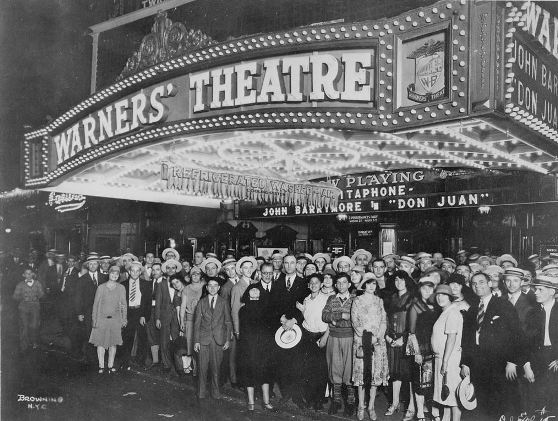
Source: Fitzhugh Green, The Film Finds Its Tongue (New York: G.P. Putnam, 1929), pp. 11-14
Text: Slowly the theatre filled. Every seat was sold, and occupied. It was a curious, speculative audience, there on unfamiliar grounds, uncertain what it was about to see, or how it should be received. It was prepared more to see a scientific marvel than to be entertained.
The four men were prepared—for anything.
Eight-thirty arrived. The lights dimmed; babble of voices hushed. A white beam shot overhead and splashed upon the screen; the beam from the movie projector. But it fell first on the draped curtains on the stage, revealing a subtitle. The curtains parted on a conventional cinema screen. The title gave way, familiarly, to a photograph … a man … Will H. Hays. He advanced to the foreground and there was a little sound. It penetrated through people’s minds that they had “heard” him clear his throat.
Then, suddenly, the picture began to speak!
The audience hung on its every word, half expecting something to happen … the machinery would break down. In the first trials of every machine there is a good chance that it will break. One lacks confidence in it.
The phenomenon was like watching a man flying without wings. It was uncanny. The shadow of Will H. Hays was true to life. His lips moved and sound came forth. His was a short speech; when it was done and he stood there, people found themselves clapping, unconsciously. As if he heard them, he bowed. He seemed to be present, and yet he did not seem to be present. No wonder a scientist next day called it: “The nearest thing to a resurrection!”
As the picture disappeared a buzz of talk ran through the theatre. Then silence again as the second number appeared: the Philharmonic Orchestra playing the “Tannhauser” overture. Sweet music reached out from the huge invisible horn behind the screen and wrought its spell upon the listeners. It was familiar music, marvellously played. It swept on through the cadences of the overture; the quiet, half-religious opening, the seductive melody of the Venusberg, the crashing finale … and during it the photographs, leaping from one section of the orchestra to another, focusing on busy musicians bent over their instruments.
As the movie image of Henry Hadley turned to his auditors after the last note he “faced” a theatre full of people applauding spontaneously—yet he wasn’t there!
The ice had been broken: the talking picture had now an audience for the first time in three decades.
Throughout the rest of the first half of the program the audience sat breathlessly drinking the novelty in. It found that it liked film that talked. It found it possible to judge such a film; it liked some of the numbers better than others. It found itself fascinated by the intimacy with which the artist was revealed; found itself watching Elman’s fingering, Martinelli’s tone formation; found itself brought closer to those artists than ever before; even found itself, presently, gaining an illusion that the artists themselves were present!
When the lights went up for intermission the audience cheered, then gave way to a concentrated buzz of excitement. History was being made and they were there to see the event, was the way every one felt.
The second half was a conventional screen drama—also with the new talking-picture attachment. But before its stirring plot was done the little group of men who waited received their verdict. The uncontrollable enthusiasm of the audience gave it:
“You win!”
Comments: Fitzhugh Green was author of a booklet that documents the development of the sound film by the American studio Warner Bros. The event he documents here is the public debut of the Vitaphone talkie film process (film accompanied by synchronised sound disc) on 6 August 1926 at the Warner Theatre, New York. Eight short films shown on the evening followed by the feature film Don Juan (1926), which had a synchronised music score and sound effects but no spoken dialogue. The short films shown were Hon. Will H. Hays, President of the Motion Picture Producers & Distributors of America, Inc., Who Will Address You (the only ‘talkie’ of the evening), Overture “Tannhauser” featuring conductor Henry Hadley and the New York Philharmonic Orchestra, violinist Mischa Elman playing “Humoresque” by Antonín Dvorák and “Gavotte” by François-Joseph Gossec, His Pastimes featuring novelty guitarist Roy Smeck, Beethoven’s The Kreutzer Sonata played by Harold Bauer and Efrem Zimbalist, a selection of Russian songs and dances entitled An Evening on the Don, singer Anna Case and Spanish dancers in La Fiesta, and opera singer Giovanni Martinelli singing Vesti La Giubba (the hit of the evening). The four men were the four Warner brothers.
Links: Copy at Hathi Trust